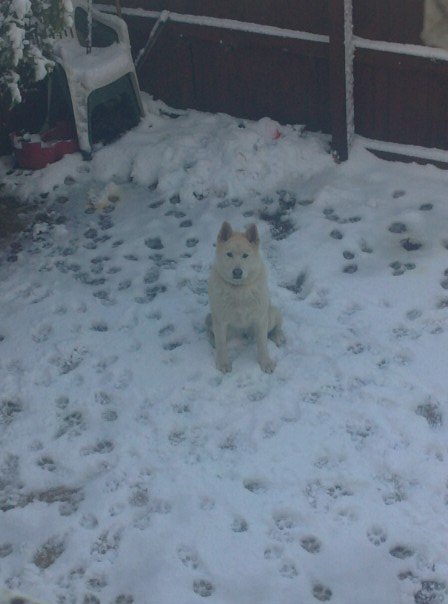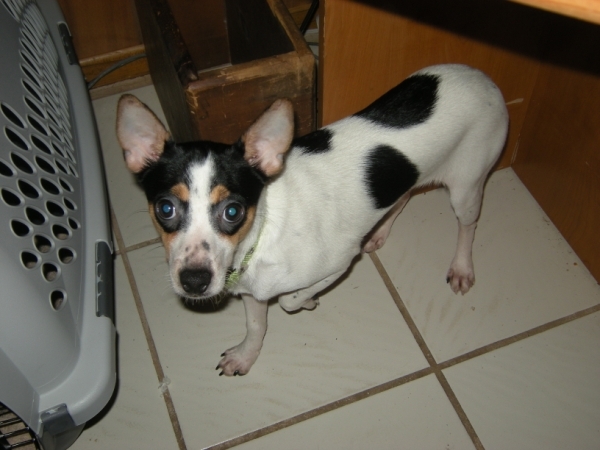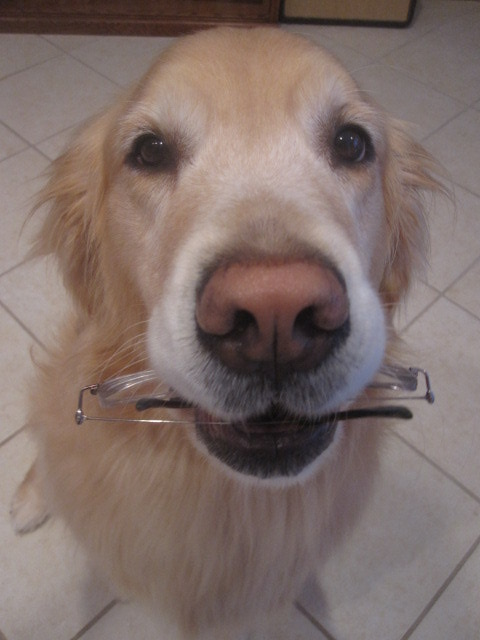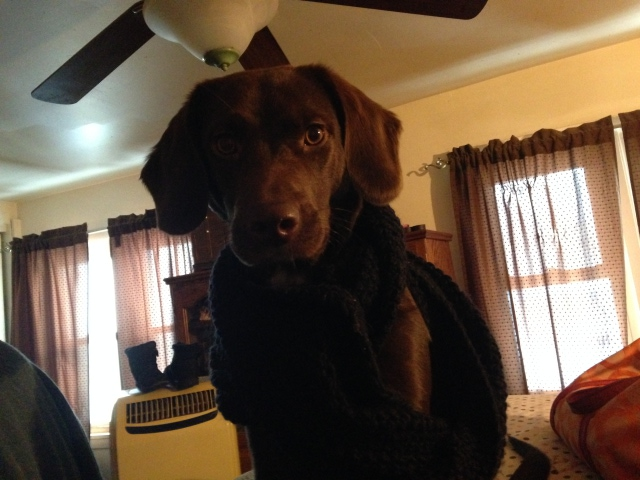QuestionHi,we have a 12week old westhighland terrior.we use a crate to train
him,we have made his bed on a cosy blanket just big enough for him to
turn around with a little bowl if water in.but find every morning he has
poo'd init.we have been training this way for 1week.we are also putting
him out last thing at nite then first thing in morning.I hope you can
help.thanks sam
AnswerYour pup should be able to sleep through the night without a problem, but sometimes they need a trip out in the middle of the night to go to the bathroom. You may be able to reduce this by feeding earlier in the evening so your pup has more opportunity to get all bathroom duties finished.
I've included some links to my web site and pasted some house and crate training information here. If you still need additional help, let me know.
Good Luck!
Links:
http://www.outlawchinooks.com/articles.html
http://www.outlawchinooks.com/dog_Potty_Training.html
http://www.outlawchinooks.com/dog_crate_training.html
Dog - Potty Training Basics
Going to the bathroom in the house is one of the biggest issues for new puppy owners. You can easily win the battle if you are consistent, patient, use supervision, utilize confinement and reward your pup with scrumptious treats. Remember, you are teaching your puppy where to relieve him or herself rather than where not to relieve him or herself.
One of your first steps is to choose a place that you want your pup to eliminate. Once you have chosen the spot, always take your pup on leash to the spot and stand there for three to five minutes. If you don't have success, take pup back inside and place them in their crate. When you are home, make this trip every hour or two and praise success with voice and treats to expedite the learning process. You pup will quickly learn that elimination bring tasty rewards.
Use a Crate. Most dogs love their "den" as long as it is the right size. If it is too big, part of it will become a bathroom. If it is too small, it is uncomfortable. Your pup should have enough room to stand up, turn around and lay down. When pup is in the crate, provide a food stuffed chew toy like a Kong so pup has something to occupy the confinement time. The crate should help you predict when the pup needs to "go" so you can teach pup where and why it needs to eliminate outdoors.
Outside Time: Puppies need to relieve themselves frequently. Ideally, your pup should go outside every two hours.
Same Time, Same Place: Take pup out on a six-foot leash and stand in the place you want pup to "go." Praise pup for "going" in the right location.
Boo Boo? Show pup his mistake and let him know he was wrong with a firm "No!" Take pup outside and show him how you want it done. (Not literally!)
Don't rub pup's nose in "it" unless you want him to eat "it."
Don't smack him with a rolled up newspaper unless you want him to eat it. If you want to hit something with a newspaper, roll it up and hit yourself for not paying more attention to pup's needs.
Feed to Succeed: A high quality, nutritional, highly digestible diet keeps odors, waste and trips outside to a minimum.
Take pup out:
* After eating
* After napping
* After a play session
* First thing in the morning
* Last thing at night
* When his eyes are crossed
The biggest key to house training success is consistency. The more consistent you are with pup, the quicker pup will give you the desired response. When pup relieves himself outside, pup earns more free time inside your home. One quick method is alternating freedom and confinement.
On a basic level the following guidelines will help you train your puppy:
* Follow the house-training schedule strictly. If pup has an accident you have allowed too much freedom.
* While standing in one spot with pup on a leash, allow two minutes for relieving himself. Reward immediately (within one second) with a treat or praise after the desired behavior.
* Holding "it" all night is the first stage to successful housebreaking.
If your puppy whines and cries at night, please try to ignore the commotion and go back to sleep. (This applies unless pup is hurting itself.) If you get up even to reprimand pup for making noise, you have just shown your pup that you will get up at night. Occasionally dogs must relieve themselves at night, and ignoring will lead to a big mess in the morning. You can respond to the pup's warning by allowing pup out for only two minutes.
For an easy routine to assist in quickly training your pup to "go outside" and avoid most accidents, follow this simple schedule:
* In the morning, carry your pup outside and place it on the ground (attached to your leash) that you have designated as the bathroom. Give your command to "go to the bathroom" or "potty" or "tinkle" or some other suitable phrase. Allow two minutes for a response. Gently repeat the command (in a tone of voice like you use with your coworkers) and as soon as pup responds, reward immediately. Remember to bring your reward treat with you no matter how optimistic or pessimistic you feel.
* If pup fails to respond within the allotted time, carefully take it inside and place it back in the crate until you are dressed and ready to try again.
* When your pup responds correctly, give lots of praise and of course your scrumptious treat. Giving the treat reinforces the desired behavior.
* Now pup is going to the bathroom outside and can earn some freedom in your home. The following table shows a suggested daytime schedule.
Goes to the bathroom outside
1/2 hour free time
1-1/2 hours of confinement
This routine continues until pup learns to "go" on command and earns your trust. At that time you can allow more freedom then go to the next level.
Goes to the bathroom outside
1 hour free time
2 hours confinement
This routine continues until pup is doing well. At that time you can allow more freedom.
Goes to the bathroom outside
2 hours free time
2 hours confinement
This entire process may take up to six weeks. Follow the basics covered here and DON'T become discouraged. They are only pups once and we should enjoy all aspects of new companion's lives.
~~~~
Crate Training
Most dog owners, experts, veterinarians and trainers recommend crates (also called cages and kennels) as the best and safest way to raise a puppy. People who have never used a crate while training a puppy may initially be opposed to the thought of crating their pup, but after using a crate have discovered that the puppy loves the crate and it helps with housebreaking, traveling and keeping you sane.
Dogs are den animals and really like having a place of their own. It's like a dog apartment in your home, a place for pooch to get away from the confusion in your house and know it is in a safe haven. Think of your crate as a safe and secure place that your dog understands from his hard wiring of his wild ancestors. Remember not to anthropromorphize your feelings about a confined space. Dogs love to den and the crate is an excellent solution for them.
A crate allows you to train your puppy and have control over pup when you are not at home. Pups left home alone with too much roaming ability can become anxious, lonely and bored, all of which can lead to disasters in your home and for your pup. By using a crate, you create a positive behavioral pattern which enables the relationship between you and your dog to develop and grow in a positive manner.
Some additional benefits of crate training your dog:
* Virtually eliminates house training problems and "accidents" in your house.
* Saves you money in repairing and replacing damaged household items and furniture.
* Assures that pup will learn good habits.
* Eliminates the chance that you will give up your pup because you can't deal with behavioral issues.
There are many styles of crates available for your companion. You will most likely start with a wire or plastic crate. Wire crates offer plenty of ventilation and a good view of pup's surroundings. Plastic crates also have good ventilation and can be used to ship dogs on airlines. Some newer style crates are quite attractive and can match your home's decor.
Dog Crate Vari Kennel Plastic
Wicker
Dog Crate Wire
Tips for Crate Training
* Have a positive attitude toward crate training. You are helping your dog and doing them a favor by using the crate. A crate trained dog is more confident, more secure, has less stress and is a more functional member of your family.
* Use a crate that will be the correct size for your adult size dog to stand up, turn around and lie down inside. If your pup will grow to be a bigger dog, create a smaller space for pup now by sliding in a piece of heavy cardboard or masonite about half way back in the crate. When pup gets bigger, simply remove the divider and the crate will be the right size.
* Keep your crate in a semi-private space in the people part of your house like the kitchen or family room. Make sure your spot is away from drafts and direct heat.
* Well before bedtime, place your pup in the crate and give a treat. Close and latch the crate door.
* Immediately start a routine with your puppy learning to use the crate for nap time and whenever pup must be alone for 3-4 hours. Once you get back, immediately take pup from the crate to your outside bathroom spot and praise for elimination, then go immediately inside. Your puppy will quickly pick up on this association and will learn house training quickly. Your relationship with your pet will be enhanced if you provide consistent structure.
* If pup resists crate confinement you want to take a non nonsense attitude. Teaching your dog to accept crate confinement is not cruel. At the first sign of separation responses like howling or barking, intervene with a sharply raised voice. The idea is for your pup to associate his barking and howling to the sharply raised voice. Some pups will not respond to the sharply raised voice, most will respond to the shaker can (Altoids tin or coffee can with coins inside works great) or a newspaper or fly swatter slapped sharply against the crate door.
* The majority of puppies will quiet down after 3-8 attempts at emotional responses. Once your puppy quiets down, keep him in the crate for an additional 10 minutes. Do not praise the puppy immediately after releasing it from the crate as you don't want pup to think getting out of the crate is the desirable behavior.
* After about 30-45 minutes, repeat the procedure of putting pup in the crate. Extend quiet time to around 30 minutes, then gradually extend your away time and in a very short period you will be able to be gone for several hours.
* Line your crate with some type of soft bedding material. There are ready made crate pads or even a towel or old blanket will suffice. Make sure pup has one safe chew toy in the crate. Other than treats, don't put food or water inside the crate. Remove collar and tags when crating your dog to prevent accidental entanglement.
* Remember, your secure happy dog will help you to be a secure happy owner.
For more in depth crate training information you can order a copy of
A Pet Owner's Guide to the Dog Crate by Nicki Meyer. The back of my copy says: Additional copies 0.20 cents each.
Contact information is:
Nicki Meyer Educational Effort, Inc.
31 Davis Hill Road
Weston, CT 06883
203.226.9877
<>

 Dog Training And Punishment?
Question
Maya
hi there i have an akita X husky,
Dog Training And Punishment?
Question
Maya
hi there i have an akita X husky,
 Potties insides but NEVER outside...
Question
This is my buddy :)
I have a 6 month old Fox T
Potties insides but NEVER outside...
Question
This is my buddy :)
I have a 6 month old Fox T
 My mini-daschund is breaking ME in
Question
Tyson!
My miniature daschund is 8 months now,
My mini-daschund is breaking ME in
Question
Tyson!
My miniature daschund is 8 months now,
 question about beagle puppy
QuestionHello, I have recently acquired a beagle puppy.
question about beagle puppy
QuestionHello, I have recently acquired a beagle puppy.
 1 year old Choco Lab is very skiddish...
Question
Ginger Coture
Hello there, I have a 1 y
1 year old Choco Lab is very skiddish...
Question
Ginger Coture
Hello there, I have a 1 y